 W
WBiological control or biocontrol is a method of controlling pests such as insects, mites, weeds and plant diseases using other organisms. It relies on predation, parasitism, herbivory, or other natural mechanisms, but typically also involves an active human management role. It can be an important component of integrated pest management (IPM) programs.
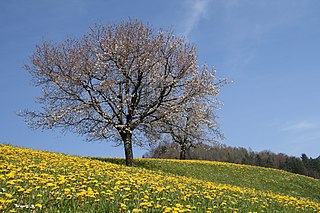 W
WThis is a list of undomesticated or feral plants, generally considered weeds, yet having some positive effects or uses, often being ideal as companion plants in gardens.
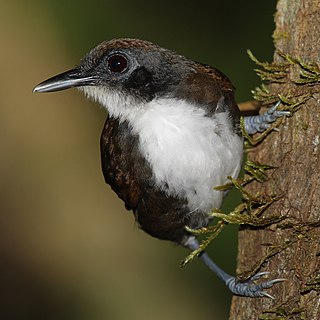 W
WAnt followers are birds that feed by following swarms of army ants and take prey flushed by those ants. The best-known ant-followers are 18 species of antbird in the family Thamnophilidae, but other families of birds may follow ants, including thrushes, chats, ant-tanagers, cuckoos, motmots, and woodcreepers.
 W
WAntifeedants are organic compounds produced by plants to inhibit attack by insects and grazing animals. These chemical compounds are typically classified as secondary metabolites in that they are not essential for the metabolism of the plant, but instead confer longevity. Antifeedants exhibit a wide range of activities and chemical structures as biopesticides. Examples include rosin, which inhibits attack on trees, and many alkaloids, which are highly toxic to specific insect species.
 W
WA nest box, also spelled nestbox, is a man-made enclosure provided for animals to nest in. Nest boxes are most frequently utilized for birds, in which case they are also called birdhouses or a birdbox/bird box, but some mammalian species such as bats may also use them. Placing nestboxes or roosting boxes may also be used to help maintain populations of particular species in an area. The modern nest box was invented by the British conservationist Charles Waterton in the early 19th century to encourage more birdlife and wildfowl on the nature reserve he set up on his estate.
 W
WA beneficial weed is an invasive plant not generally considered domesticated that has some companion plant effect, is edible, contributes to soil health, adds ornamental value, or is otherwise beneficial. Beneficial weeds include many wildflowers, as well as other weeds that are commonly removed or poisoned.
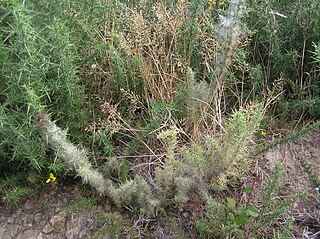 W
WBiological control programs for gorse in New Zealand have existed since the introduction of the gorse seed weevil in 1928. Biological pest control is the use of natural mechanisms such as predation to limit the growth and prevalence of a pest. The early research into the biological control of common gorse in New Zealand was among the first of such programs worldwide.
 W
WA bodega cat is a cat that inhabits a bodega, which in New York City English refers to a convenience store or deli. Much like farm cats and ship cats, a bodega cat is typically a mixed breed cat kept as a form of biological pest control to manage or prevent rodent infestations.
 W
WCalligrapha pantherina, the sida leafbeetle, is a species of beetle in the family Chrysomelidae, endemic to Mexico. The larvae and adult beetles feed on the foliage of the common wireweed and the arrowleaf sida. This beetle has been introduced into Northern Australia as a biological control agent in an attempt to control its host plants, which are invasive weeds there.
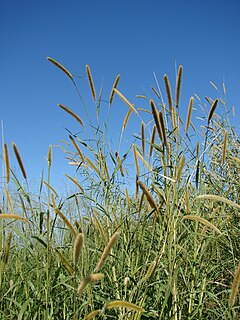 W
WCenchrus purpureus, synonym Pennisetum purpureum, also known as Napier grass, elephant grass or Uganda grass, is a species of perennial tropical grass native to the African grasslands. It has low water and nutrient requirements, and therefore can make use of otherwise uncultivated lands. Historically, this wild species has been used primarily for grazing, recently, however, it has been used as part of a push–pull agricultural pest management strategy. Napier grasses improve soil fertility, and protect arid land from soil erosion. It is also utilized for firebreaks, windbreaks, in paper pulp production and most recently to produce bio-oil, biogas and charcoal.
 W
WChrysolina hyperici is a species of beetles of the family Chrysomelidae.
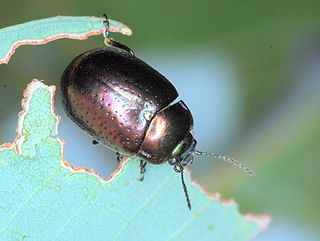 W
WChrysolina quadrigemina is a beetle of the family Chrysomelidae.
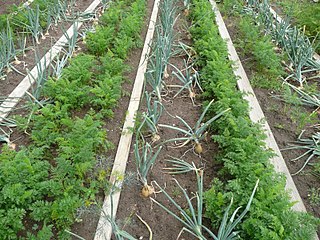 W
WCompanion planting in gardening and agriculture is the planting of different crops in proximity for any of a number of different reasons, including pest control, pollination, providing habitat for beneficial insects, maximizing use of space, and to otherwise increase crop productivity. Companion planting is a form of polyculture.
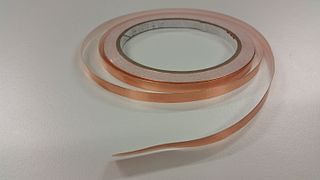 W
WCopper tape refers to a thin strip of copper, often backed with adhesive. Copper tape can be found at most hardware and gardening stores and sometimes electronic stores. Copper tape is used to keep slugs and snails out of certain areas in gardens, potted plants, and trunks of fruit trees, and other trees and shrubs. It is also used for other applications, such as electromagnetic shielding or low-profile surface mount transmission line in electronics and in the production of tiffany lamps. It comes in two forms; conductive adhesive and non-conductive adhesive.
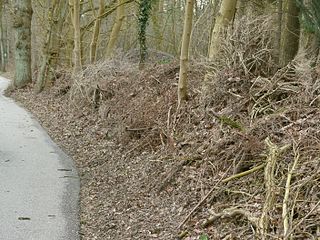 W
WA dead hedge is a barrier constructed from cut branches, saplings, and foliage. The material can be gathered from activities such as pruning or clearing, and in traditional forms of woodland management, such as coppicing. Its ecological succession can be a beetle bank or hedge.
 W
WFlufenoxuron is an insecticide that belongs to the benzoylurea group, which also includes diflubenzuron, triflumuron, and lufenuron.
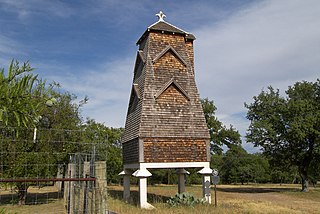 W
WThe Hygieostatic Bat Roost is located in Kendall County, approximately 1.5 miles (2.4 km) east of Comfort on the south side of RM 473, in the U.S. state of Texas. It was erected in 1918 on property owned by former San Antonio Mayor Pro Tem Albert Steves, who had commissioned San Antonio health officer Dr. Charles A. R. Campbell to design the structure. The shingled pyramid-shaped raised tower stands 30 feet (9.1 m) high. One dormer serves as an entrance for the bats, while the other dormers are ornamental. The lower portion of the tower allows access for humans. The concrete base of the tower is raised 7 feet (2.1 m) off the ground, facilitating wagons being driven beneath to collect the guano.
 W
WAn insect hotel, also known as a bug hotel or insect house, is a manmade structure created to provide shelter for insects. They can come in a variety of shapes and sizes depending on the specific purpose or specific insect it is catered to. Most consist of several different sections that provide insects with nesting facilities – particularly during winter, offering shelter or refuge for many types of insects. Their purposes include hosting pollinators.
Integrated pest management (IPM), also known as integrated pest control (IPC) is a broad-based approach that integrates practices for economic control of pests. IPM aims to suppress pest populations below the economic injury level (EIL). The UN's Food and Agriculture Organization defines IPM as "the careful consideration of all available pest control techniques and subsequent integration of appropriate measures that discourage the development of pest populations and keep pesticides and other interventions to levels that are economically justified and reduce or minimize risks to human health and the environment. IPM emphasizes the growth of a healthy crop with the least possible disruption to agro-ecosystems and encourages natural pest control mechanisms." Entomologists and ecologists have urged the adoption of IPM pest control since the 1970s. IPM allows for safer pest control.
 W
WIsaria is a genus of fungi mostly in the order Hypocreales and family Clavicipitaceae, or by some authorities the Cordycipitaceae. It includes a large number of entomopathogenic species, some of them exploited as biopesticides : often previously assigned to the genus Paecilomyces.
 W
WLarinus is a genus of true weevils, comprising about 180 species, mostly in the Palaearctic region. Turkey appears to have a significant diversity of the group, with more than 50 species recorded in the Eastern part of the country.
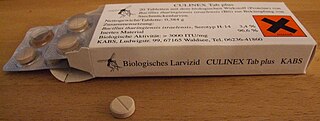 W
WA larvicide is an insecticide that is specifically targeted against the larval life stage of an insect. Their most common use is against mosquitoes. Larvicides may be contact poisons, stomach poisons, growth regulators, or (increasingly) biological control agents.
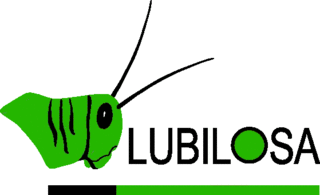 W
WLUBILOSA was the name of a research programme that aimed at developing a biological alternative to the chemical control of locusts. This name is an acronym of the French title of the programme: Lutte Biologique contre les Locustes et les Sauteriaux. During its 13-year life, the programme identified an isolate of an entomopathogenic fungus belonging to the genus Metarhizium and virulent to locusts, and went through all the necessary steps to develop the commercial biopesticide product Green Muscle based on its spores.
 W
WOrange oil is an essential oil produced by cells within the rind of an orange fruit. In contrast to most essential oils, it is extracted as a by-product of orange juice production by centrifugation, producing a cold-pressed oil. It is composed of mostly d-limonene, and is often used in place of pure d-limonene. D-limonene can be extracted from the oil by distillation.
 W
WIn evolutionary ecology, a parasitoid is an organism that lives in close association with its host at the host's expense, eventually resulting in the death of the host. Parasitoidism is one of six major evolutionary strategies within parasitism, distinguished by the fatal prognosis for the host, which makes the strategy close to predation.
 W
WA pheromone trap is a type of insect trap that uses pheromones to lure insects. Sex pheromones and aggregating pheromones are the most common types used. A pheromone-impregnated lure, as the red rubber septa in the picture, is encased in a conventional trap such as a bottle trap, Delta trap, water-pan trap, or funnel trap. Pheromone traps are used both to count insect populations by sampling, and to trap pests such as clothes moths to destroy them.
 W
WPlant defense against herbivory or host-plant resistance (HPR) describes a range of adaptations evolved by plants which improve their survival and reproduction by reducing the impact of herbivores. Plants can sense being touched, and they can use several strategies to defend against damage caused by herbivores. Many plants produce secondary metabolites, known as allelochemicals, that influence the behavior, growth, or survival of herbivores. These chemical defenses can act as repellents or toxins to herbivores, or reduce plant digestibility.
 W
WPlant Genetic Systems (PGS), since 2002 part of Bayer CropScience, is a biotech company located in Ghent, Belgium. The focus of its activities is the genetic engineering of plants. The company is best known for its work in the development of insect-resistant transgenic plants.
 W
WPlant use of endophytic fungi in defense occurs when endophytic fungi, which live symbiotically with the majority of plants by entering their cells, are utilized as an indirect defense against herbivores. In exchange for carbohydrate energy resources, the fungus provides benefits to the plant which can include increased water or nutrient uptake and protection from phytophagous insects, birds or mammals. Once associated, the fungi alter nutrient content of the plant and enhance or begin production of secondary metabolites. The change in chemical composition acts to deter herbivory by insects, grazing by ungulates and/or oviposition by adult insects. Endophyte-mediated defense can also be effective against pathogens and non-herbivory damage.
 W
WPolyculture is a form of agriculture in which more than one species is grown at the same time and place in imitation of the diversity of natural ecosystems. Polyculture is the opposite of monoculture, in which only members of one plant or animal species are cultivated together. Polyculture has traditionally been the most prevalent form of agriculture in most parts of the world and is growing in popularity today due to its environmental and health benefits. There are many types of polyculture including annual polycultures such as intercropping and cover cropping, permaculture, and integrated aquaculture. Polyculture is advantageous because of its ability to control pests, weeds, and disease without major chemical inputs. As such, polyculture is considered a sustainable form of agriculture. However, issues with crop yield and biological competition have caused many modern major industrial food producers to continue to rely on monoculture instead.
 W
WPredation is a biological interaction where one organism, the predator, kills and eats another organism, its prey. It is one of a family of common feeding behaviours that includes parasitism and micropredation and parasitoidism. It is distinct from scavenging on dead prey, though many predators also scavenge; it overlaps with herbivory, as seed predators and destructive frugivores are predators.
 W
WPurpureocillium lilacinum is a species of filamentous fungus in the family Ophiocordycipitaceae. It has been isolated from a wide range of habitats, including cultivated and uncultivated soils, forests, grassland, deserts, estuarine sediments and sewage sludge, and insects. It has also been found in nematode eggs, and occasionally from females of root-knot and cyst nematodes. In addition, it has frequently been detected in the rhizosphere of many crops. The species can grow at a wide range of temperatures – from 8 to 38 °C for a few isolates, with optimal growth in the range 26 to 30 °C. It also has a wide pH tolerance and can grow on a variety of substrates. P. lilacinum has shown promising results for use as a biocontrol agent to control the growth of destructive root-knot nematodes.
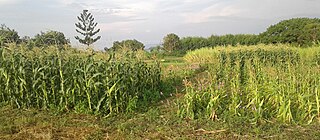 W
WPush–pull technology is an intercropping strategy for controlling agricultural pests by using repellent "push" plants and trap "pull" plants. For example, cereal crops like maize or sorghum are often infested by stem borers. Grasses planted around the perimeter of the crop attract and trap the pests, whereas other plants, like Desmodium, planted between the rows of maize, repel the pests and control the parasitic plant Striga. Push–pull technology was developed at the International Centre of Insect Physiology and Ecology (ICIPE) in Kenya in collaboration with Rothamsted Research, UK. and national partners. This technology has been taught to smallholder farmers through collaborations with universities, NGOs and national research organizations.
 W
WThe pyrethrins are a class of organic compounds normally derived from Chrysanthemum cinerariifolium that have potent insecticidal activity by targeting the nervous systems of insects. Pyrethrin naturally occurs in chrysanthemum flowers and is often considered an organic insecticide when it is not combined with piperonyl butoxide or other synthetic adjuvants. Their insecticidal and insect-repellent properties have been known and used for thousands of years.
 W
WSpinosad is an insecticide based on chemical compounds found in the bacterial species Saccharopolyspora spinosa. The genus Saccharopolyspora was discovered in 1985 in isolates from crushed sugarcane. The bacteria produce yellowish-pink aerial hyphae, with bead-like chains of spores enclosed in a characteristic hairy sheath. This genus is defined as aerobic, Gram-positive, nonacid-fast actinomycetes with fragmenting substrate mycelium. S. spinosa was isolated from soil collected inside a nonoperational sugar mill rum still in the Virgin Islands. Spinosad is a mixture of chemical compounds in the spinosyn family that has a generalized structure consisting of a unique tetracyclic ring system attached to an amino sugar (D-forosamine) and a neutral sugar (tri-Ο-methyl-L-rhamnose). Spinosad is relatively nonpolar and not easily dissolved in water.
 W
WTansy is a perennial, herbaceous flowering plant of the aster family, native to temperate Europe and Asia. It has been introduced to other parts of the world, including North America, and in some areas has become invasive. It is also known as common tansy, bitter buttons, cow bitter, or golden buttons. The Latin word vulgare means "common".
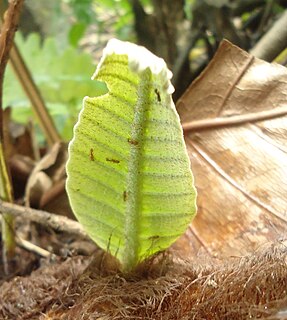 W
WTritrophic interactions, as they relate to plant defense against herbivory, describe the ecological impacts of three trophic levels on each other: the plant, the herbivore, and its natural enemies. They may also be called multitrophic interactions when further trophic levels, such as soil microbes, or hyperparasitoids, are considered. Tritrophic interactions join pollination and seed dispersal as vital biological functions which plants perform via cooperation with animals.
 W
WTrophobiosis is a symbiotic association between organisms where food is obtained or provided. The provider of food in the association is referred to as a trophobiont. The name is derived from the Greek τροφή trophē, meaning "nourishment" and -βίωσις -biosis which is short for the English symbiosis.